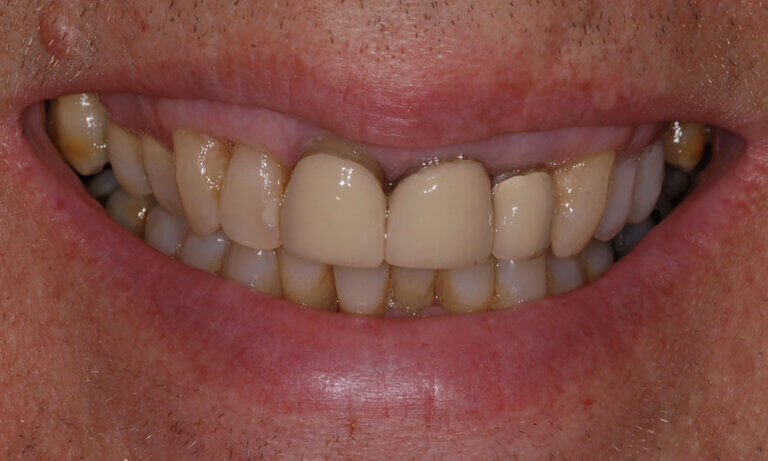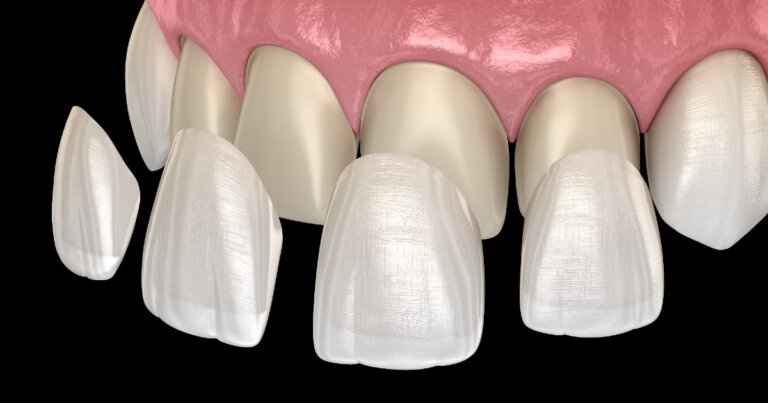Dental Veneer Overhanging Margin

What Is A Dental Veneer Overhanging Margin?
A Dental Veneer is a custom-made, thin shell that is bonded to the front surface of a tooth to enhance its appearance. Made from materials like porcelain or composite resin, veneers replicate the color, shape, and texture of natural teeth. An important aspect of successful veneer placement is ensuring a smooth, seamless transition from tooth to veneer. This helps prevent bacteria and food particles from getting trapped along the edge, known as the “margin.” However, if a veneer is improperly designed or bonded, an “overhanging margin” may occur, where the edge of the veneer extends slightly beyond the tooth surface. While minor overhangs may not cause immediate issues, they can trap food and bacteria over time, leading to problems like tooth decay, gum disease, and even tooth loss.
Before you contact a Toronto dentist to examine A Dental Veneer Overhanging Margin, there are some things you should know as a patient:
- Causes of Dental Veneer Overhanging Margins
- Signs And Symptoms Of A Dental Veneer Overhanging Margin
- Treatment Options For A Dental Veneer Overhanging Margin
- Managing A Dental Veneer Overhanging Margin Until You Can See The Dentist
- Frequently Asked Questions About Dental Veneer Overhanging Margins
If you have questions about A Dental Veneer Overhanging Margin or other dental problems, please contact us for more information.
Causes of Dental Veneer Overhanging Margins
Several factors can contribute to an overhanging margin on a dental veneer, including:
Inaccurate Veneer Design: The dental lab creating your veneer must ensure that it perfectly aligns with your tooth preparation to avoid any ledge or overhang. A seamless transition is crucial to prevent bacteria from collecting along the margin.
Poor Veneer Impression: Sometimes, issues arise during the impression stage. If traditional physical impressions are used instead of modern digital impressions, they may be less accurate. Additionally, factors like moisture, blood, or excess gum tissue covering the tooth margins can impact the quality of the impression, leading to a poorly fitting veneer.
Understanding these causes can help you take preventive steps or address the issue if it occurs. For more information on overhanging margins, consult your dentist. If you have further questions about why you might have a Dental Veneer Overhanging Margin, please contact us.
Signs And Symptoms Of A Dental Veneer Overhanging Margin
If you have a dental veneer with an overhanging margin, you may notice some or all of the following signs and symptoms:
- Tooth Sensitivity: Increased sensitivity to hot or cold foods and beverages may indicate an issue with the veneer fit.
- Tooth Pain: Pain when chewing or biting can suggest an overhanging margin.
- Gum Swelling or Discomfort: Swelling or tenderness in the gums around the veneer may indicate that debris or bacteria are accumulating under the overhang.
- Food Trapping: Food particles may become lodged between the overhanging margin and your gums, leading to discomfort and requiring more frequent flossing around the veneer.
- Visible Ledge Under Veneer: A noticeable ledge or overhang along the edge of the veneer can often be felt with your tongue.
- Dark Discoloration Under Veneer: Discoloration or a grayish tint beneath the veneer could signal tooth decay, infection, or staining from trapped debris.
- Floss Shredding: If your floss frequently tears when used around the veneer, it may be catching on an overhanging margin.
If you experience any of these symptoms, it’s essential to schedule a dental appointment. A dentist can assess the veneer and determine if an overhanging margin is present, as leaving it untreated can lead to tooth decay, gum disease, and other complications. If you have further questions about the signs and symptoms of a Dental Veneer Overhanging Margin, please contact us.

Treatment Options For A Dental Veneer Overhanging Margin
If you have a dental veneer with an overhanging margin, your dentist may suggest one or more of the following treatment options:
- Veneer Adjustment: In cases where the overhanging margin is minor and accessible, the dentist may be able to adjust the veneer, removing a small amount of material to eliminate the ledge and create a better fit.
- Veneer Replacement: If the overhanging margin is extensive or the veneer is damaged, your dentist may recommend replacing it with a properly fitting one to ensure optimal comfort and function.
- Root Canal Therapy: If the overhanging margin has resulted in significant tooth decay or damage, a root canal may be necessary to remove the affected tissue and preserve the remaining tooth structure.
- Crown Lengthening Gum Surgery: In cases where gum tissue obstructs the tooth preparation, a procedure to remove excess gum tissue can expose more of the tooth, allowing for a better veneer fit.
The most suitable treatment will depend on the cause and severity of the overhanging margin. Early treatment can help prevent decay and other complications. If you have further questions about treatment options for a Dental Veneer Overhanging Margin, please contact us.
Managing A Dental Veneer Overhanging Margin Until You Can See The Dentist
If you suspect an overhanging margin and are waiting for a dental appointment, try these steps to manage the issue temporarily:
- Practice Good Oral Hygiene: Keep the affected area as clean as possible to prevent decay and manage discomfort. Brush and floss gently around the veneer and rinse with salt water to reduce inflammation.
- Use Over-the-Counter Pain Relievers: Pain medication, such as ibuprofen (Advil) or acetaminophen (Tylenol), can help alleviate pain or sensitivity. Check with your dentist if you’re unsure about dosing.
- Avoid Chewing on the Affected Side: Reducing pressure on the affected area can help prevent further irritation and discomfort.
These steps can help manage symptoms until your appointment. However, it’s essential to consult your dentist as soon as possible for a long-term solution. If you have further questions about how to manage and treat a Dental Veneer Overhanging Margin, please contact us.
Frequently Asked Questions About Dental Veneer Overhanging Margins
- What causes overhanging margins in dental veneers?
Overhanging margins can result from inaccuracies during the impression-taking process, improper veneer fabrication, or errors in placement, leading to the veneer extending beyond the tooth’s natural contour.
- How can I tell if my veneer has an overhanging margin?
Signs may include difficulty flossing around the veneer, gum irritation, swelling, or persistent bad breath.
- Can overhanging margins cause gum recession?
Yes, overhanging margins can irritate the gums, leading to inflammation and eventual gum recession if not addressed promptly.
- Is it possible to develop sensitivity from an overhanging margin?
Yes, an overhanging margin can expose sensitive areas of the tooth or irritate the gums, leading to increased sensitivity to hot, cold, or sweet foods and drinks.
Addressing an overhanging margin in a dental veneer is essential to prevent oral health issues such as gum disease and tooth decay. If you have further questions about how to manage and treat a Dental Veneer Overhanging Margin, please contact us.

